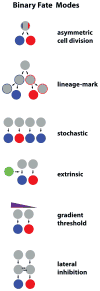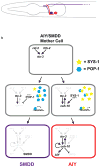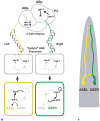Binary fate decisions in differentiating neurons
- PMID: 20022236
- PMCID: PMC2827633
- DOI: 10.1016/j.conb.2009.11.002
Binary fate decisions in differentiating neurons
Abstract
Neural cell fate programs must generate an enormous number of neurons with distinct adult functions. The decision to choose one neuronal subtype from two alternatives--a binary fate decision--is one way to diversify neuronal subtypes during nervous system development. Recent progress has been made in describing the genetic programs that define late-stage neuronal identity. Here, we review mechanisms that control how such fate decisions generate two different postmitotic, terminally differentiated neuronal subtypes. We survey examples from Caenorhabditis elegans and Drosophila that demonstrate different modes of binary neuronal fate specification that depend on cell division, lineage, stochastic gene expression, or extracellular signals. Comparison of these strategies reveals that, although organisms use diverse approaches to generate neural diversity, some common themes do exist.
2009 Elsevier Ltd. All rights reserved.
Figures




Similar articles
-
Lineage programming: navigating through transient regulatory states via binary decisions.Curr Opin Genet Dev. 2010 Aug;20(4):362-8. doi: 10.1016/j.gde.2010.04.010. Epub 2010 May 27. Curr Opin Genet Dev. 2010. PMID: 20537527 Free PMC article. Review.
-
Neurogenesis in the nematode Caenorhabditis elegans.WormBook. 2010 Oct 4:1-24. doi: 10.1895/wormbook.1.12.2. WormBook. 2010. PMID: 20891032 Free PMC article. Review.
-
Identification of genes driving lineage divergence from single-cell gene expression data in C. elegans.Dev Biol. 2014 Sep 15;393(2):236-244. doi: 10.1016/j.ydbio.2014.07.009. Epub 2014 Jul 19. Dev Biol. 2014. PMID: 25050933 Free PMC article.
-
Lineage analysis of Drosophila lateral antennal lobe neurons reveals notch-dependent binary temporal fate decisions.PLoS Biol. 2012;10(11):e1001425. doi: 10.1371/journal.pbio.1001425. Epub 2012 Nov 20. PLoS Biol. 2012. PMID: 23185131 Free PMC article.
-
Gene regulatory patterning codes in early cell fate specification of the C. elegans embryo.Elife. 2024 Jan 29;12:RP87099. doi: 10.7554/eLife.87099. Elife. 2024. PMID: 38284404 Free PMC article.
Cited by
-
Neuronal birthdate reveals topography in a vestibular brainstem circuit for gaze stabilization.Curr Biol. 2023 Apr 10;33(7):1265-1281.e7. doi: 10.1016/j.cub.2023.02.048. Epub 2023 Mar 15. Curr Biol. 2023. PMID: 36924768 Free PMC article.
-
Computational analysis of synergism in small networks with different logic.J Biol Phys. 2023 Mar;49(1):1-27. doi: 10.1007/s10867-022-09620-0. Epub 2022 Dec 29. J Biol Phys. 2023. PMID: 36580168 Free PMC article.
-
Binary regulation of Hippo pathway by Merlin/NF2, Kibra, Lgl, and Melted specifies and maintains postmitotic neuronal fate.Dev Cell. 2011 Nov 15;21(5):874-87. doi: 10.1016/j.devcel.2011.10.004. Epub 2011 Nov 3. Dev Cell. 2011. PMID: 22055343 Free PMC article.
-
Tcf7 is an important regulator of the switch of self-renewal and differentiation in a multipotential hematopoietic cell line.PLoS Genet. 2012;8(3):e1002565. doi: 10.1371/journal.pgen.1002565. Epub 2012 Mar 8. PLoS Genet. 2012. PMID: 22412390 Free PMC article.
-
Feedforward regulation ensures stability and rapid reversibility of a cellular state.Mol Cell. 2013 Jun 27;50(6):856-68. doi: 10.1016/j.molcel.2013.04.014. Epub 2013 May 16. Mol Cell. 2013. PMID: 23685071 Free PMC article.
References
-
- Jessell TM. Neuronal specification in the spinal cord: inductive signals and transcriptional codes. Nat Rev Genet. 2000;1:20–29. - PubMed
-
- Price SR, Briscoe J. The generation and diversification of spinal motor neurons: signals and responses. Mech Dev. 2004;121:1103–1115. - PubMed
-
- Edlund T, Jessell TM. Progression from extrinsic to intrinsic signaling in cell fate specification: a view from the nervous system. Cell. 1999;96:211–224. - PubMed
-
- Livesey FJ, Cepko CL. Vertebrate neural cell-fate determination: lessons from the retina. Nat Rev Neurosci. 2001;2:109–118. - PubMed
Publication types
MeSH terms
Grants and funding
LinkOut - more resources
Full Text Sources
Molecular Biology Databases

